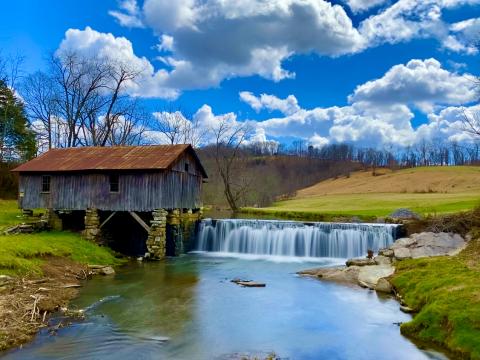What is a Creek?
By Steve Roark
Volunteer, Cumberland Gap National Historical Park
I like looking over topographic maps, and I got to pondering all the different forms of water flow that show on a map. We have rivers, creeks, streams (also called brooks), and springs. I found myself asking what makes a creek a creek and a river a river? I assumed there was some size classification set up so that if a body of flowing water was so many feet wide it was a river. Research revealed that a creek is a vague concept.
The dictionary defines a creek a small stream, somewhat larger than a brook. A river is defined as a stream larger than a creek, quite vague and unsatisfying, so I forged on and found no size classification to determine a creek from a river. But I did get some descriptions that might help, so here goes.
A river typically carries a large volume of water, has a distinct channel, and eventually empties into a larger river or an ocean. A creek is an “in between” stream that carries water to a river. A brook or stream is a small flow of water that starts off as water surfacing from an underground source, like from springs. I also ran across other stream terms such as a rivulet, another name for a stream. There are also “branches” named on topographic maps, such as Water Prong Branch near where I live.
There is no minimum length to be classified as a river, but width and depth do figure into it. The best description I found is that if you can throw a rock across it, it’s usually called a creek. If it's too wide for a rock throw and is deep enough for boats, it's a river.
Whatever you call them, streams are the conduits that carry rain and snow back to the ocean and offer humans a tremendous resource of water for drinking, washing, fishing, and natural beauty. Nothing calms the nerves like sitting by small stream and listen to its serenade as it flows past. The Bible mentions the importance of streams in Deuteronomy: “The Lord God bringeth thee into a good land, a land of brooks of water.” Our water resources are vast but can still be ruined by carelessness, so please help protect our waters and keep them clean. Construction of homes and roads can put a lot of silt into streams without proper planning, and the same goes for timber logging and farming. Contact the proper Resource Agency in your area for advice or assistance on any project that may affect water quality. Agencies that can help include the Natural Resources Conservation Service, UT Agricultural Extension, and the TN Division of Forestry.
- Log in to post comments
